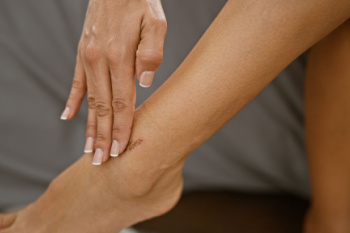
Chronic sores on the lower extremities are wounds that fail to heal within a normal timeframe and often reappear or worsen over time. They may develop due to poor circulation, diabetes, vein disease, or repeated pressure on fragile skin. These sores are more common among older adults, individuals with limited mobility, and people with underlying health conditions that interfere with blood flow or immune function. Left untreated, chronic sores can lead to infection, significant discomfort, and reduced quality of life. Treatment may involve advanced wound dressings, compression therapy, infection control, and specialized techniques to stimulate tissue repair. Preventive care includes regular skin checks, wearing protective footwear, and proper management of health conditions that affect healing. Professional care makes a critical difference in recovery, which is why it is suggested that you see a wound care specialist if you have a chronic sore on your lower extremity.
Wounds on the feet, ankles, and legs require special attention because these areas are extremely vulnerable to infection and slower healing. Even a small scrape or cut can become more serious if not treated promptly, particularly for individuals with diabetes, poor circulation, or weakened immune systems.
Abrasions occur when the skin is rubbed or scraped against a rough surface, often leaving raw, painful patches that expose delicate tissue. On the feet and legs, these are more susceptible to contamination from shoes, socks, and daily activities. Cuts and scrapes that break through deeper layers of the skin create open wounds that may bleed and require proper cleaning and covering to reduce risk of infection.
Some injuries are more complex. Traumatic wounds, such as lacerations caused by accidents or falls, can damage not only the skin but also the underlying structures of the foot or ankle. Puncture wounds from sharp objects are another concern, as they are often narrow and deep, allowing bacteria to become trapped inside. These injuries may not look severe on the surface, but can result in serious infection if not evaluated by a wound specialist.
Because the lower extremities play such a vital role in mobility, untreated wounds in this region can interfere with daily activities, and, in severe cases, threaten long-term health. Proper wound care includes cleaning, dressing, and monitoring the injury, and in some cases, advanced treatment to close or debride the wound and support faster healing.
If you have a cut, abrasion, or puncture wound on your foot, ankle, or leg that is not improving or appears infected, call us for help today. Prompt treatment ensures effective healing and helps protect your mobility and overall health.
